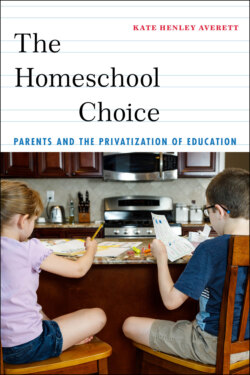Читать книгу The Homeschool Choice - Kate Henley Averett - Страница 21
Current Trends: Who Homeschools?
ОглавлениеThe number of homeschooled students has increased continually over the last several decades.38 While education analysts estimate that somewhere around ten to fifteen thousand children were homeschooled in the United States in 1970,39 most current estimates place the number of homeschooled children in the United States at between 1.5 and 2 million, with some estimates over 2 million.40 According to data from the National Center for Education Statistics (NCES), approximately 1.75 million students, or 3.3% of school-age children in the United States, were homeschooled during the 2015–2016 school year (the most recent year for which data are available).41 However, these point-in-time estimates only provide us with part of the picture: a 2012 national poll found that 7% of mothers would prefer to homeschool their children than send them to public, private, and charter schools,42 and scholars estimate that between 5% and 12% of all students will have been homeschooled at some point during their K–12 education.43
Demographic research on homeschoolers has shown that homeschooling parents tend to be more highly educated than nonhomeschooling parents, with a greater percentage having received high school degrees, engaged in postsecondary education, and received a college diploma. Most research finds that homeschooling families tend to be middle class; both low-income and high-income families tend to be underrepresented among homeschoolers. Homeschoolers are disproportionately likely to be white, though there is evidence that this disproportionality is shrinking, as the number of minority children being homeschooled has increased in the last decade. Homeschoolers also tend to be in heterosexual, married, single-income families with one stay-at-home parent—usually the mother.44
Two noteworthy changes have taken place in recent years regarding who homeschools and why. First, homeschooling in the United States is no longer dominated by Evangelical Christians in the way that it once was. In the 1980s and into the 1990s, much of the growth in homeschooling was due to the practice being taken up by conservative Evangelicals. In 1999, the majority of homeschoolers—about 65%—were primarily motivated by a desire to educate their children in ways that aligned with their religious convictions.45 This has changed in recent years. According to the NCES, in 2012, 64% of homeschooling parents said that “a desire to provide religious instruction” was one of the important reasons why they homeschooled; this number fell to just over half of homeschooling parents (51%) by 2016. In both 2012 and 2016, only 16% of parents said that providing religious instruction was the most important reason they chose to homeschool.46 By comparison, in 2007 (the first year the NCES asked parents to choose the most important reason), 36% of parents chose religious instruction—and this was the most common response.47 In both 2012 and 2016, however, the most common response homeschooling parents gave to the question of the single most important reason for homeschooling was “a concern about environment of other schools,” with 25% of parents choosing this response in 2012 and a remarkable 34% doing so in 2016.48
Second, scholars note that the last decade has seen a marked growth in homeschooling by nonwhite families.49 While caution is recommended when using NCES data to estimate homeschooling rates by racial/ethnic group due to the very small sample size of racial-/ethnic-minority homeschoolers, and sometimes-inconsistent reporting of statistically adjusted versus nonadjusted estimates, it is evident that there is a shift. NCES estimates have the percentage of homeschoolers who are white decreasing from 75% in 1999 to 59% in 2016, and the percentage who are Hispanic increasing from 9% in 1999 to 26% in 2016. The percentage of homeschoolers who are from other minority groups has remained relatively more stable, however, with the percentage who are Black at 8–10%, the percentage who are Asian/Pacific Islander at 2–4%, and the percentage of those identified as other at 4–7%.50 However, other scholars argue that there has been an increase in participation in homeschooling by Black families.51
The reason for this growth, particularly in Hispanic homeschoolers, is not clear. The limited research that has been done that focuses on nonwhite homeschoolers has been conducted almost entirely on Black homeschoolers, with almost no research on Hispanic or Asian/Pacific Islander homeschoolers.52 This research has tended to show that some Black homeschoolers choose to homeschool in part as a means of racial protectionism, either to prevent their children from experiencing racism in schools (including racialized discipline, low expectations, and other racial microaggressions from teachers, administrators, and peers) or in response to a specific incident of racism, if their children had already been enrolled in traditional schools.53 Some of these parents are also motivated to homeschool by the ability to include culturally relevant materials in their children’s education (though, researchers point out, some also homeschool for reasons that mirror those of white parents, particularly for those who are fundamentalist Christians).54 Homeschooling researcher Cheryl Fields-Smith argues, on the basis of a review of periodicals, blog posts, and other informal documentation, that there is good reason to believe motivations might be similar for many Hispanic parents as well.55
